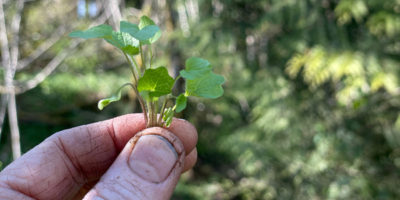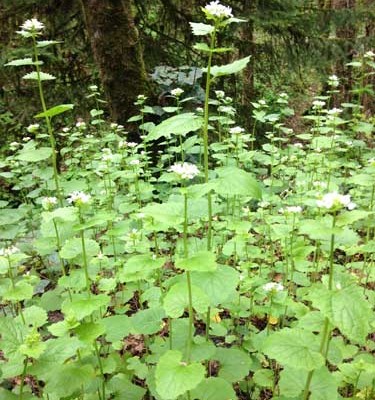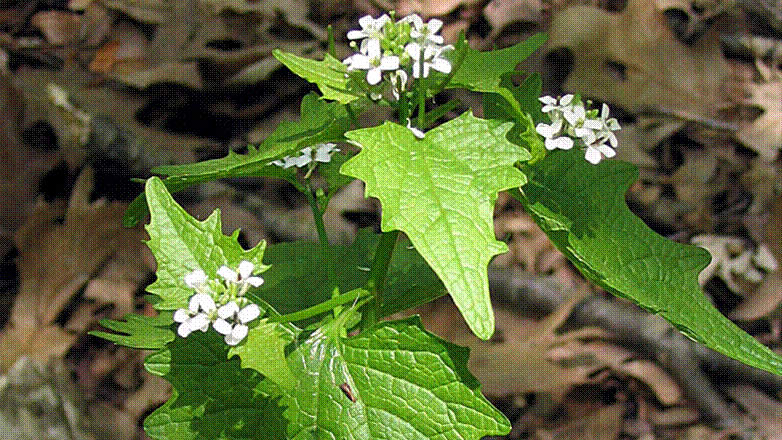
A few tiny remaining garlic mustard plants found in 2021 in one of the waterways that drain into Forest Park. Several large garlic mustard patches in the area are now home to a growing diversity of native plants, including fringecup, Pacific waterleaf, wood violet, Pacific bleeding heart and western trillium.
After 10 years of garlic mustard control, our staff and community is observing substantially less garlic mustard on the landscape! Through these diligent early detection and control efforts, we are seeing resilient native plants return where there were once large garlic mustard infestations. Garlic mustard directly impacts the diversity of plant species in our forests. Preventing and controlling the spread of garlic mustard is essential to supporting the health of our forests, insects, animals and waterways.
During the ongoing coronavirus pandemic, District staff and contractors will be working carefully to conduct priority work while adhering to state and CDC-recommended guidelines. We are being very thoughtful about where we conduct field work at this time, and are prioritizing time-sensitive projects that we’ve committed to, which includes the control of garlic mustard in impacted areas.
Read Frequently Asked Questions to learn more about this year’s Garlic mustard treatment season.

Garlic mustard infestation
Find the Garlic mustard locations being treated by City of Portland Bureau of Environmental Services this year.
Controlling Garlic mustard
The key to controlling garlic mustard (Alliaria petiolata) is to attack infestations early this spring before the plants have a chance to go to seed. Garlic mustard is a priority for control because it quickly invades shaded woodland habitats and alters soil chemistry. That makes the woods less hospitable to our native plants and dramatically decreases forage for native animals.
Garlic mustard is a biennial plant. In its first year it appears as a low growing rosette with kidney-shaped scalloped leaves that smell like garlic if you crush them. In our climate, many of these rosettes overwinter and as soon as the weather begins to warm up they grow very rapidly. In the second year, in early spring, the plants grow tall (12-48 inches) and feature white flowers with four-petals each that quickly transform into seed pods.
The best time to pull garlic mustard is when it has just started flowering, before any seeds have been made. Pulling works best if the soil is moist such as after rainfall. Be sure to pull at the base of the plant and to get all the roots out, because roots left in the ground can re-sprout and form new plants. It is best to put all flowering plants in bags and dispose of with your trash, because plants that are pulled and laid on the soil may set seed. Do not place garlic mustard plants in compost or any other vegetative material, where the seeds can remain alive.
Prevention is crucial! Clean your boots, bike tires, pets and car tires after traveling through infested patches. Try to be strategic about not spreading the infestation on your own property by working from the outside of the infestation in and then cleaning your boots with a brush after leaving the infested areas.
Read more about garlic mustard in this brochure.
Garlic mustard management in Portland
Garlic mustard was discovered in the West Hills of Portland in 2007 by residents around Forest Park, and since then several property owners, volunteer groups, and natural resource agencies have come together to combat this aggressive, noxious invasive plant. Regionally, garlic mustard extent is limited. Managed populations are found in the greater Portland Metro and Seattle areas, with only few known occurrences elsewhere in these states.
Within western Multnomah County, garlic mustard population centers are located near Skyline (between Burnside and Newberry Roads) and SW Portland (particularly Council Crest and near Lewis and Clark College). West Multnomah Soil & Water Conservation District, and our partners, provide free landowner assistance in managing garlic mustard infestations.
Using environmentally-sound integrated pest management approaches, we have seen good progress in reducing populations and minimizing the spread of garlic mustard. Over 400 properties have been surveyed, and 150 property owners receive annual assistance with control. Currently, less than 30 acres are impacted at project sites, and your help is needed in finding and managing additional unknown patches.
Read more about garlic mustard in this brochure.
How can you help
Fill out a WMSWCD Permission to Access and Control Form form to have your property surveyed by our staff.
Take a weed watchers class (Visit the Weed Watcher page and sign-up when classeshttps://wmswcd.org/project/garlic-mustard-containment/permission-to-access-private-land-control-target-weeds_2024/ become available)
Contact our Invasive Species Program Coordinator Michelle Delepine at 503.238.4775, ext. 115 or michelle@wmswcd.org for more information about the Garlic Mustard Program.
